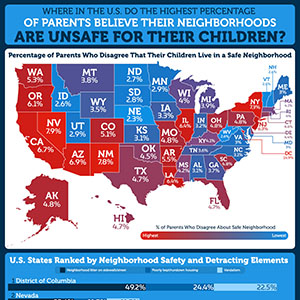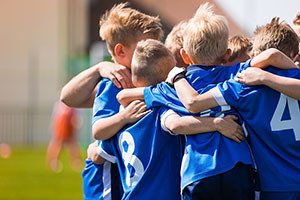Posted by Dr. Julia Tortorice
Creating a safe, healthy, and happy home for children is a goal shared by millions of Americans. Unfortunately, extenuating circumstances often contribute to less-than-ideal living situations. The team at PARequirements.com has analyzed data from the National Survey of Children’s Health to determine which states are the most unsafe for children based on their neighborhood conditions.
It is important to highlight these unsafe neighborhoods in the United States because a child’s health, happiness, and success often begin at home. While many children can thrive in various environments, living in a safe neighborhood can significantly boost their mental, physical, and social well-being. By showcasing which states have the most rundown housing, vandalism, and litter, we can pinpoint patterns and spur targeted efforts. Here are the results:
Click here to download the printable PDF version of the chart.
Why Is Washington, D.C. So Dangerous?
While Was...
Posted by Mary Thompson
As the winter months roll in, classrooms, clinics, and counseling offices often take on a unique energy. The shorter days, colder weather, and anticipation of holidays can stir up a mix of emotions in children – excitement, fatigue, restlessness, and sometimes anxiety. Routines may shift, energy levels fluctuate, and even the most even-tempered students can feel off balance.
In these moments, the presence of a caring adult can make all the difference. For many children, school and other environments offer consistency they may not have elsewhere. Whether you are a teacher greeting your students each morning or a nurse helping a nervous child through a vaccination, your daily interactions form the backbone of emotional safety and connection.
It‘s easy to underestimate the impact of small gestures — a smile, a word of encouragement, or a moment of genuine attention. But research continues to show that children thrive when adults consistently show care in even the s...
Posted by Mary Thompson
E-cigarettes and vaping have exploded in popularity among adolescents in recent years, evolving from a niche trend to a widespread concern in middle schools and high schools alike. What started as “safer” alternatives to cigarettes has morphed into devices that many teens use daily, often in secret.
This trend is especially relevant in school settings, where teachers and counselors may be the first to notice changes in behavior, health, or academic performance. Beyond the immediate health risks, vaping can disrupt learning, shift social dynamics, and contribute to disciplinary or mental health issues.
This blog is crafted for educators, school counselors, and youth professionals in Pennsylvania (and beyond). Its goal is to help you spot warning signs of vaping, understand the motivations behind it, and respond effectively with support, not shame.
What are E-Cigarettes and Vaping Devices?
E-cigarettes (also called electronic cigarettes or vapes) are battery-p...
Posted by Mary Thompson
Youth sports play a powerful role in shaping children’s lives. From building confidence and discipline to encouraging teamwork and resilience, sports can be one of the most positive influences in a young person’s development. Yet, these environments can also become unsafe when proper safeguards are not in place.
Coaches and Volunteers often hold significant authority over athletes. That power comes with responsibility–not just to teach the rules of the game, but to protect the well-being of every child in their care. In Pennsylvania, anyone working with children in a supervisory role, including coaches and sports volunteers, is considered a mandated reporter under state law. This legal and ethical duty means recognizing the warning signs of abuse and taking action when concerns arise.
The purpose of this article is to help coaches and volunteers identify the different types of abuse that can occur in sports, understand the risk factors, r...
Posted by Dr. Julia Tortorice
Bullying is a widespread problem affecting millions of children across the United States, with more than one-third of children aged 6 to 17 having experienced it at least once in the past year. From school bullying to cyberbullying, the issue has only grown in recent years.
A survey conducted by The Child & Adolescent Health Measurement Initiative shows that bullying is much more prevalent in certain states than others. Using data from their 2022–2023 National Survey of Children’s Health, the team at PARequirements.com created a graphic highlighting the U.S. states with the highest rates of children who are bullied and those with the highest rates of children who bully others.
The National Survey of Children’s Health provides data on the percentage of children aged 6–17 who have either experienced bullying — meaning they were “bullied, picked on, or excluded by other children in the past 12 months” — or who have bull...





